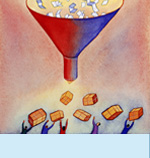


  |
||||
| PRINTER FRIENDLY VERSION
The Exorbitant Cost of Not Doing Marketing Research Note to Salesgenie.com's CEO: A little investment in research generates a huge return. 
A Major Retailer Discovers that Ideas are Beautiful, but Reality Is Something Else Vinod Gupta isn't the only top executive to become enamored with his own creativity. The Salesgenie.com ad debacle reminded me of another marketing campaign developed by a retail chain leadership team. Fortunately, those executives had the good sense to test the materials before going public. I'll never forget the shock experienced by the campaign's creators when they saw the reactions of their intended audiences. By the time I was retained, a seven-figure budget had already gone into the creation of advertising and internal communications materials that featured real employees. It was my job to test the communications with focus groups to determine if they were relevant and would produce the desired reactions and results. The stores in the materials looked wonderful. Inviting. Immaculate. Smiling employees welcomed you. Salespeople exhibited pride in their work. Several mentioned their impressive employee benefits: health insurance, 401K plans and paid vacations. Others spoke of their aspirations to become store managers. These proud, joyful team members encouraged the public to shop at their stores and consider working with them. I showed the employees in the first focus group the materials and asked the following questions: "What's the main idea behind what you see?" "Would you notice this ad if you were looking through a magazine?" "How does this information make you feel about working there?" Immediately I knew we had a major problem. The employees looked angry, confused and resentful. Sample responses included:
I showed the materials to the next focus group, which consisted of seven customers. I asked: "Any immediate thoughts or feelings?" "Is the ad clear?" "How does this make you feel about shopping there?" The customers were equally incredulous:
The assistant whispered back, "Guess not." Where the Reality Hits the Road I said to the marketing team, "For now, the only thing we can do is to proceed with these focus groups and instruct the participants to react to the ads as if they are true. Our goal today isn't to poll them on their actual experiences in your stores; it's to get their responses to this campaign." The team agreed that this was the best use of our time; however, it was clear that there would be some serious accountability checking back at home office. I proceeded with the same questions to the remaining 15 focus groups. Then my team and I summarized our findings in a written report that we presented to the client two weeks later. Upon reviewing the report, the client called me and said, "I must admit, this hurts. We spent a lot of money on those materials, but I'd rather know this now than after rolling out a national, multi-million dollar campaign." As painful as the findings were, they served a valuable purpose.
NEXT ARTICLE Jenny Schade is president of JRS Consulting, Inc., a firm that helps organizations build leading brands and efficiently attract and motivate employees and customers. Subscribe to the free JRS newsletter on www.jrsconsulting.net/newsletter.html © JRS Consulting, Inc. 2008 |
 |
|||
© 2008 JRS Consulting, Inc.